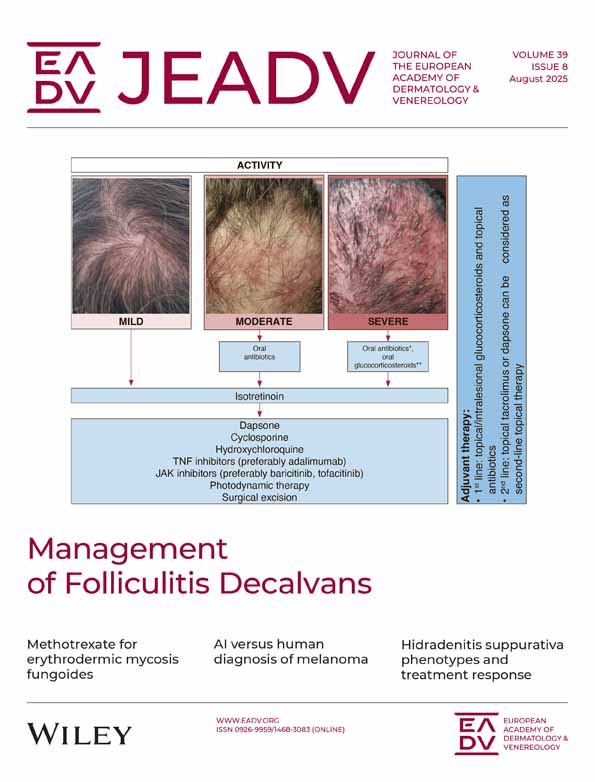Chronic radiation dermatitis: what’s new in management?
Guillen C et al. Photodynamic therapy for in situ squamous cell carcinoma on chronic radiation dermatitis after photosensitization with 5-aminolaevulinic acid. JEADV14, 298–300.
It is a fact that the different campaigns alerting people to the danger of acute and chronic overexposure of our skin to strong sun light have reduced the number of cases of squamous (SCC) and basal cell carcinomas (BCC). But it is also a fact that the number of in situ squamous cell carcinomas, solar-actinic keratosis (AK) and chronic radiation dermatitis are increasing, especially in people that have been exposed to the sun through professional activity (sailors, farmers, drivers) with little or no protection. Chronic radiation dermatitis is also seen in young fair-skinned individuals with phototype I–III that have received an excess of actinic radiation in a short period of time. This is particularly true of those cases who have been exposed to x-radiation and to ultraviolet light from artificial sources, habitually young women receiving excessive amounts of actinic radiation from tanning beds.
All of the people who develop chronic radiation dermatitis have been exposed to excessive sun light, but the percentages for SCC and AK are less predictable. SCC, BCC and AK are most common in sunny countries such as Australia, southern USA (e.g. California), Southern Europe (e.g. Italy, France, Spain) and in the Mediterranean area (e.g. Israel). Depletion of ozone is another aetiological factor for AK, as each 1% decrease in ozone is thought to produce a 2–6% increase in skin cancers.1 Ozone depletion is caused by the action of industrial chemicals, especially chlorofluorocarbons produced from aerosol sprays, discarded refrigerators and air conditioners.2
Once it has been accepted that patients are presenting frequently with chronic radiation dermatitis, the management of the problem must be considered. Whether we accept or not that chronic radiation dermatitis will always develop into AK or SCC, the patients with chronic radiation dermatitis must at least be advised that strong sun light and artificial radiation should be avoided and that they must be screened once or twice on the year for AK or SCC.
The current recommended therapies for AK and SCC can be surgical or medical. Radiosurgery, cryosurgery, or surgical extirpation can all be performed to remove AK and SCC. When the patient has chronic radiation dermatitis associated with AK, dermabrasion using diamond fraises or wire brushes is recommended.3 Although this carries the inconvenience of a week-long stay in hospital, it is well-known that this technique is the only one that treats AK and provides long-term prophylaxis.4 Carbon dioxide (CO2) laser skin resurfacing is also an excellent method to remove keratoses.
Medical treatments include the long-standing use of 5-fluorouracil or more recently the medium-depth chemical peels with Jessner’s solution and 35% trichloracetic acid.4 Nevertheless, the patient treated with a medium-deep chemical peel should be reevaluated annually or every 18 month for AK reappearance, and therefore, retreatment. More recently, imiquimod has been added to the therapeutic treatment possibilities. This gives excellent results, but it is necessary to give clear instructions for its use to the patient in order to avoid local reactions such as erosions, induration or ulceration, and subjective systemic adverse side-effects such as headache, fever, nausea, diarrhoea, arthralgia or pain.5
Chronic radiation dermatitis has two treatment options, the first being oral retinoids, such as acitretin, which have an antitumour effect, and are useful as a prophilaxis and as therapy. A more recent treatment is photodynamic therapy using topical 5-aminolevulinic acid (ALA) which has proved useful in the treatment of various superficial cutaneous malignant neoplasms such as basal cell carcinomas, Bowen disease and AK or, as is indicated in this issue (pp. 298–300), chronic radiation dermatitis. The difference between these two therapies is that acitretin is easily available to all dermatologists whereas photodynamic therapy is only available to a few.
Finally, it should be noted that we now have products that provide excellent sun protection and a Sun Protection Factor (SPF) of no less than 30 must be recommended to prevent immunosupression.2




